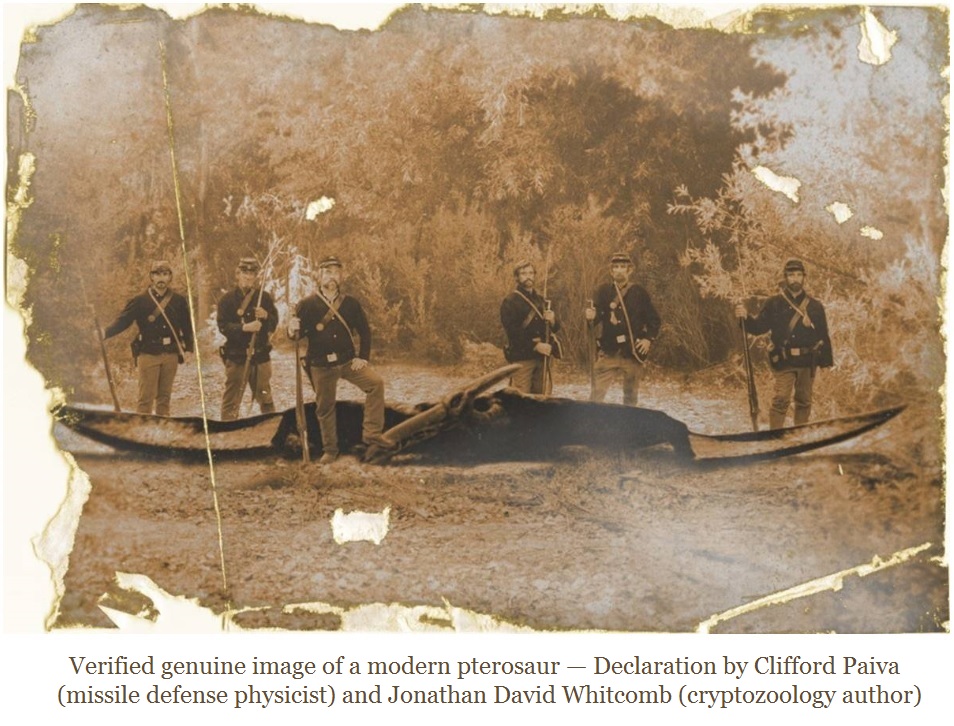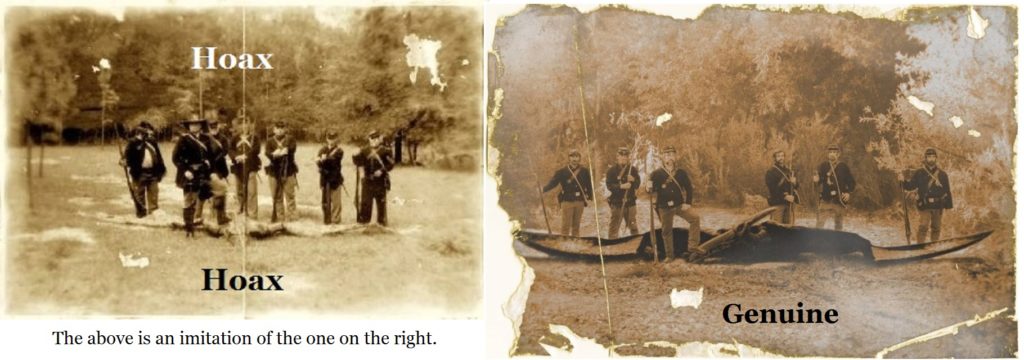By modern-pterosaur expert Jonathan Whitcomb
Have you ever checked out two books from a library, finding one fascinating but the other boring? When the due date approaches, which one will you remember to return to the library?
The following photograph has been around for a long time. It may be the image that caught my attention around 1968, while I was browsing the shelves of a public library in Pasadena, California. Other persons seem to remember this “pterodactyl” photo from about that time. Perhaps it was in one of the old “Believe it or not” books, or something similar, from the mid-20th-century.
Figure-1: Apparent Civil-War Photograph of a Modern Pterosaur (Ptp)
Unfortunately, the two-books story is only symbolic. I do not have the old library book gathering dust on my book shelf and waiting for someone to open it and gaze at the above image. But the photo itself has been sitting around for a long time, visible online but not recognized for what it is: evidence for a modern pterosaur. It is now labeled “Ptp.”
The point is this: The accumulating fine is a delayed confirmation that people all over the world have not been crazy for seeing large featherless non-bat flying creatures overhead. Eyewitnesses in Western countries have mostly kept quiet, not wanting to be labeled “crazy” or “foolish.” It’s time to stop that accumulating penalty and take that image off the shelf.
Don’t confuse the Ptp Civil War photograph with the Freakylinks-TV-show hoax photo. That television series, on the Fox Network, aired from 2000 to 2001, and Civil-War reenactors were used to create an imitation of what is now called “Ptp.” Notice the difference in Figure-2:
Figure-2: Hoax reenactment on the left and the original on the right (click)
.
Evidence for Authenticity
Both photos have some origin in photographic recording. The Freakylinks hoax was staged with real men who were not really Civil War soldiers, and the photo was manipulated to look old, possibly through Photoshop. The other photograph, now declared to have a genuine image of a modern pterosaur—that one shows evidence of authenticity in more than one way. Detailed image-analysis by the physicist Clifford Paiva confirms my own examination: A recently-deceased modern pterosaur was indeed photographed.
Much has already been written, early in 2017, on this. Let’s take a look at two clues on the ground in front of the apparent Pteranodon. These would not be expected from a Photoshop hoax creation of a pterosaur model (digital, inside a computer) or from a physical model. They could be expected, however, if a real animal had been photographed.
What would we expect if a large animal had been shot dead by Civil War soldiers? Would the creature likely have fallen to the ground in a perfect location to be photographed: perfectly visible in a clearing? No, it would probably fall dead in a poor location. When the photographer arrived, however, he would ask the soldiers to drag the carcass into a nearby clearing, out from under the bushes or other hindrances to photography. Would not the dragging leave a mark on the ground? Quite possibly, if not quite likely.
Now click on the Figure-1 image. Notice the drag mark on the ground: from the lower right to near the end of the beak of the dead flying creature. Now look at the ground just in front of the wing on our right. Below the second soldier from the right is a broken-down little tree; it’s just in front of the wing.
Now combine those two pieces of evidence. To be properly photographed, a large animal would need to be dragged out into a clearing where it could be seen clearly and have sufficient light. Before getting to that final resting place, however, the small tree would have been broken down and leveled to the ground. It looks small enough that the sapling could have been stepped on to do that.
Notice that those two clues make much less sense if the soldiers had spent a lot of time constructing a physical model. In that case, the construction would have taken place in the clearing, with no need to drag the model anywhere. And that tiny tree would have been no real problem, hardly big enough to obscure the view of the model.
No consider the placement of the soldiers in Figure-1 (Ptp photo). Where would the photographer have asked the soldiers to stand? If it was a real animal, he’d want the men standing behind the body of the monster. If it was only a constructed model, however, they would have all agreed to stand in front of the fake dragon, especially placed for hiding the greatest weaknesses in their creation.
“What Happened to Pterosaurs?”
The following is taken from an old page I had published online many years ago: “A Weakness in Western Mentality.” I was afraid that it had become extinct when my web host discontinued service, but fortunately it was preserved. Here is part of it, partly revised:
It seems we have a conflict between reports of eyewitness encounters and “accepted” scientific ideas about pterosaur extinction. That needs careful evaluation. It’s unwise to summarily dismiss foreign testimonies simply because they seem to contradict popular assumptions of many Western scientists.
Accepting universal pterosaur-extinction blindly, without leaving open any door for objective investigation, is not scientific but smells of dogmatism. Such skepticism is not worthy to be associated with the word “science” unless there is some solid evidence for the extinction of ALL species of pterosaurs. There is no such evidence.
On the other hand, holding a skeptical eye to claims of pterosaur extinction is valid if there is a reasonable number of eyewitnesses of pterosaur-like creatures living alongside humans. The most recent estimate of eyewitness numbers is as follows (paraphrased from the fourth edition of Searching for Ropens and Finding God):
Of the billions of persons now living, the number of those who have had some kind of encounter with a modern living pterosaur is quite possibly between 7-million and 128-million.
Conclusion
When taken in the context of countless eyewitness accounts of modern pterosaurs, the Ptp photograph must be examined with an open mind. Details in the image suggest a real animal was photographed. The resemblance of that winged creature to a Pteranodon is not evidence of a fraud but evidence that eyewitnesses around the world are telling the truth.
###
Copyright 2017 Jonathan D. Whitcomb
.
The photograph we’re examining here is called “Ptp” and has been around much longer. It was surely used, by the producers of Freakylinks, as a model for their crude imitation. . . . Ptp photograph, now declared to have a genuine image of a modern pterosaur
Ptp – Civil War Pterosaur Photograph
The photograph now called “Ptp” has been around for a long time, possibly in one or more books in the mid-20th century, according to a number of persons who report remembering it.
Don’t get Strung Along by the Smithsonian
Science writer Brian Switek, in an August, 2010, post for the online Smithsonian Magazine, titled his remarks “Don’t Get Strung Along by the Ropen Myth.” . . . [but that post has serious problems] Switek seems to have entirely failed to comprehend what is entailed here.
Pteranodon is a genus of pterosaurs that included some of the largest known flying reptiles. . . . For over 200 years, people in these areas of the United States have reported enormous birds.
.




